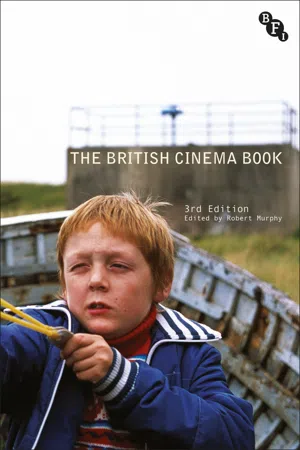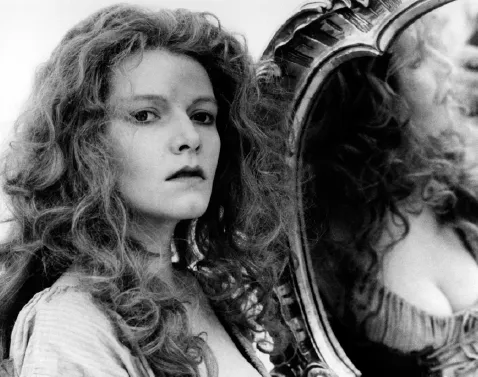![]()
PART ONE
Debates and Controversies
![]()
1
The British Cinema: The Known Cinema?
ALAN LOVELL
The great French film-maker, François Truffaut, once famously said that there was a certain incompatibility between the words British and Cinema. Well, bollocks to Truffaut.
Stephen Frears
In the late 1960s I presented a paper, ‘The British Cinema: The Unknown Cinema’, to a British Film Institute seminar group. Its starting point was a suggestion that scholarly neglect of the British cinema was so great that it was effectively an unknown cinema. A lot has changed since then. Today, British film scholars can hardly be accused of neglecting their national cinema. In the space of thirty-five years we moved from scarcity to abundance. There are now available solid histories of the British cinema; detailed explorations of British genre film-making; analyses of important historical ‘moments’; critical examinations of influential filmmakers; wide-ranging anthologies; informed discussions of the economic and cultural context of current British film-making; informative accounts of Welsh and Scottish film-making.
Inevitably, there are still gaps. My priorities for further investigation would be: the contribution of cameramen, editors, sound recordists, set and costume designers, special effects – and of their union, ACT (later ACTT, now BECTU); British film acting, especially the rich late 1940s and early 50s tradition of female acting represented by Kathleen Byron, Googie Withers, Joan Greenwood, Pamela Brown, Jean Simmons and Deborah Kerr; and the historical development of British film audiences, including a detailed account of film exhibition.1
Despite these gaps, increasing critical interest has meant that the British cinema now exists as an object for study. Its contours, at least, are visible. Undoubtedly this is a substantial achievement. But what are the consequences of this work? How is the British cinema now perceived?
It is certainly perceived more positively. If you engage in a substantial act of critical recovery/discovery, you need some belief in the value of what you are doing. When I wrote this chapter, British film criticism showed strong signs of that built-in antipathy to ‘things British’ which George Orwell complained of.2 The basic perspective was Marxist, with modern capitalism portrayed as being heavily dependent on the effects of ideology for maintaining its dominance. Cinema was seen as a major ideological institution and realism the form through which it sought to ‘naturalise’ capitalism.
But as Raymond Williams points out in Keywords, realism has a variety of meanings, some of which are contradictory.3 It’s a particularly difficult term to pin down in the context of the British cinema because definitions tend to be casual and operational rather than sustained and reflective. To encourage a more sympathetic and detailed interest in realism, I’ll offer a sketch of its historical development.
In what sense were the documentary film-makers of the 1930s realists? They were realists because they believed it was the purpose of art to provide a true understanding of the world. Art had therefore to be socially responsible, it had to have a serious relationship with society. This general belief was given a more specific character by a belief in the ‘heroism of modern life’, a heroism which was principally located in the activities of working people.4 Art could best provide a ‘true understanding’ if it focused on those activities. Artistically, this second belief is important because it pushes artists towards naturalism, which I take to be a commitment to the importance of describing surface appearances.
The belief in social responsibility has been enormously influential on the British cinema. It is most often articulated in terms of the cinema having a serious relationship with society. As such its acceptance runs pretty much without challenge through the history of the British cinema from the 1930s to the 1990s. Its power can be seen in its acceptance by the filmmakers and critics of the Screen generation, despite their claim to be ‘anti-realists’.
The belief that cinema ought to have a serious relationship with society was one of the clearest motivations for strengthening the presence of realism in feature film-making in the early 1940s. The commitment to describing the heroism of everyday life was made easy by the war, but revealing the underlying forces of social change hardly seemed relevant when what mattered was winning the war.
In pre-war documentaries like Coal Face (1935), heroism was expressed through a formalist concern with visual composition and the use of sound. Increasingly, the documentarists came to think that this formalism was inappropriate. They felt it made the films remote, cutting them off from desired audiences. A preference for naturalistic description began to shape films. Night Mail (1936), with its awkward mixture of naturalism and formalism, marks this change very well.
A successful naturalistic representation depends heavily on the ability to convince audiences that what is being represented has been accurately observed. Because of the demands of manual work and the nature of the cinema, the documentarists found it easy to represent manual work convincingly. They didn’t find it so easy to represent informal, personal relationships. Night Mail is again a good example. The representation is convincing when the men are deftly sorting the letters because they are sufficiently absorbed to ignore the film-makers. But when they are chatting and joking, they are clearly aware of the presence of the filmmakers and their banter is awkwardly self-conscious.
Realist feature films faced similar problems. In Which We Serve (1942) is impressively convincing when it represents the ordinary seamen in action. When it represents their personal life, the conviction disappears. The problems are most evident in the dialogue, which is constructed around ungrammatical forms and catchphrases giving the characters a ‘quaint’ quality. The actors add to the problems. In speaking the dialogue, they make frequent shifts between working-class and middle-class articulations. The overall effect is to patronise characters and/or make them comic.
Whatever the problems, realism clearly was a creative force in wartime feature film-making. In particular, In Which We Serve and ‘Fires Were Started –’ (1943) seem to me to be films any national cinema could be proud of. But the creative impact of realism was closely tied to the war. In the post-war British cinema, its creative impact diminished. The belief that films should have a serious relationship with society was increasingly reduced to the exploration of topical subjects from within a conventional moral/social perspective. Naturalistic description became limited to scripts based on the lives of ‘ordinary’ people plus location shooting.
As a strong, creative presence, realism was not revived until the second half of the 1950s, when the Free Cinema writers and film-makers (Lindsay Anderson, Karel Reisz, Tony Richardson) reaffirmed realist beliefs. In his essay ‘Get Out and Push!’, Anderson incisively criticised liberal critics and artists for their irresponsibility and frivolity. He also argued for the urgency and importance of providing convincing representations of working-class life.5
Anderson’s arguments were influential and played an important part in re-energising British film-making. His work was supported by the emergence of new writers (Alan Sillitoe, David Storey, Shelagh Delaney) and new actors (Rachel Roberts, Albert Finney, Richard Harris, Rita Tushingham) who, for a variety of reasons, were better able to cope with the demands of representing working-class life.6
For all its energy, this ‘kitchen sink’ realism was a short-lived and limited phenomenon. If we date its beginning to the production of Room at the Top in 1958, it was pretty much over by 1965. In fact, the dominance of realism was even more attenuated than this suggests. After Saturday Night and Sunday Morning (1960), Karel Reisz directed Night Must Fall (1964), an adaptation of a 1930s stage thriller/melodrama. He followed this with an adaptation of David Mercer’s surrealistic fantasy, Morgan, A Suitable Case for Treatment (1966). Lindsay Anderson’s first feature, This Sporting Life (1963), has obvious Expressionist elements. Tony Richardson’s first three films, Look Back in Anger (1959), The Entertainer (1960) and A Taste of Honey (1961), showed realist impulses, particularly through location-shooting, but all three were based on successful stage plays.
However, realism was not abandoned. Rather, it changed its form. In the late 1950s Brecht’s work increasingly had an impact on British artistic culture. Crucially Brecht was a realist without being a naturalist – he believed that it was art’s job to provide a ‘true understanding’ but he didn’t believe this could be achieved through a description of the surfaces of life. The encouragement his work gave to a move from naturalism was supported by the influence of surrealism, which was also prevalent at that time.7
Lindsay Anderson’s work clearly reveals both these forces at work – surrealism in If . . . . (1968), Brecht in O Lucky Man! (1973). The same processes can be seen at work in television drama. Dennis Potter’s ‘Nigel Barton’ plays (1965) are strongly marked by the influence of Brecht. David Mercer moved from the naturalistic drama of the Where the Difference Begins trilogy (1961–3) to the surrealist-influenced A Suitable Case for Treatment (1962).
It can be argued that realism with a strong naturalistic dimension survived in series and serial television forms, from Z Cars (1962–78) and Coronation Street (1960–) to Between the Lines (1992–4) and Brookside (1982–2003). In terms of the British cinema, Ken Loach has been a distinctive figure because of his commitment to maintaining realism as a viable artistic form by modernising it. To achieve this, he used the advances in camerawork and sound made possible by the cinéma-vérité movement. He also addressed the problems posed by acting for naturalistic realism in a radical way, using little-known or non-professional actors and only giving them pages of the script on a day-by-day basis in order to keep them fresh. But perhaps his greatest commitment has been the reaffirmation of the critical dimension of realism by giving it a Marxist perspective.8
The strongest positive thrust from the new scholarship has been an attempt to validate ‘anti-realist’ film-making. Contemporary scholars have explored areas of film-making represented by Hammer horror films, Gainsborough melodramas and the Carry On comedies. Julian Petley outlines this position very clearly in his essay ‘The Lost Continent’:
Of course, the vaunting and valorising of certain British films on account of their ‘realism’ entails as its corollary, as the other side of the coin, the dismissal and denigration of those films deemed un- or non-realist . . . These form another, repressed side of British cinema, a dark, disdained thread weaving the length and breadth of that cinema, crossing authorial and generic boundaries, sometimes almost entirely invisible, sometimes erupting explosively, always received critically with fear and disapproval.9
Dilute surrealism?: Dawn Archibald as the witch woman in Neil Jordan’s The Company of Wolves (1984)
The work that has been done in this area has been invaluable in calling attention to films and film-makers which have languished for too long without proper critical attention. If the claims made for them were persuasive, then a new and interesting account of the British cinema would have been constructed. Unfortunately the case for the anti-realist genres has been much weakened by its dependence for its sense of value on a ‘dilute Surrealism’. Effectively, surrealism has operated as a form of easy genre-valuing, privileging the ‘excess’ of horror films, melodrama and low comedy as against the oppressiveness of realism.
The treatment of melodrama first alerted me to the weakness of the case. I remember pre...

